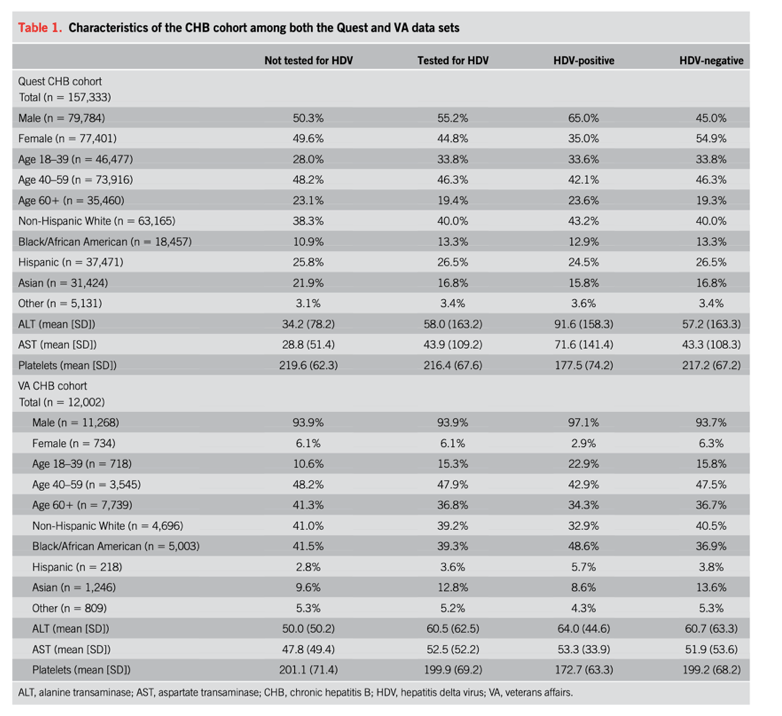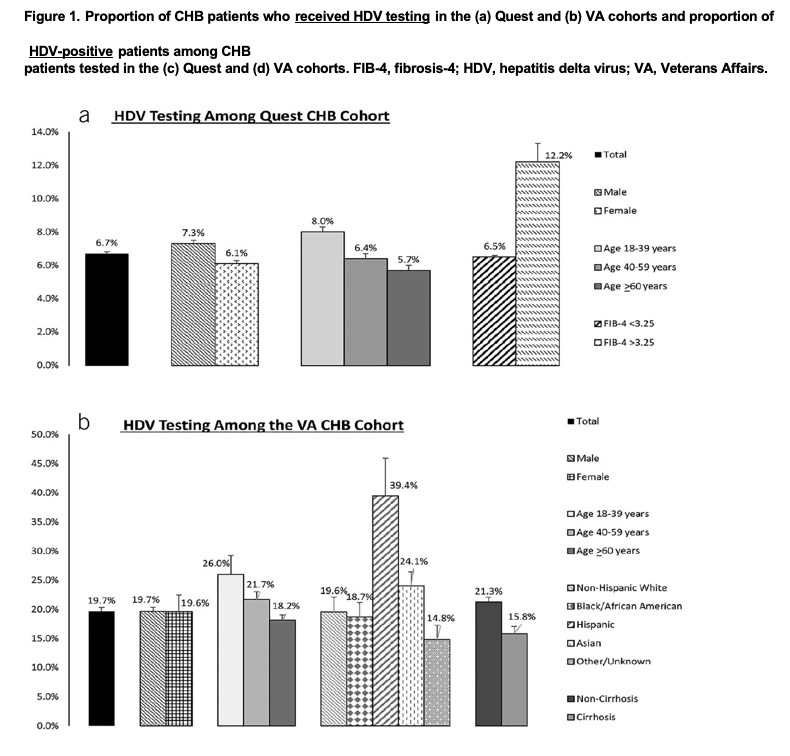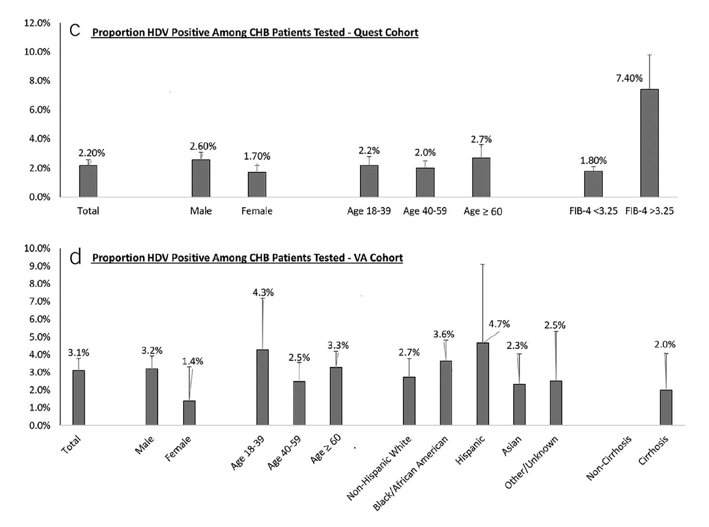| |
Low Performance of Hepatitis Delta Virus Testing Among 2 National Cohorts of Chronic Hepatitis B Patients in the United States
|
| |
| |
Download the PDF here
Robert J. Wong, MD, MS 1,2 , Harvey W. Kaufman, MD3, Justin K. Niles, MS 3, Cheng Chen, MS4 , Zeyuan Yang, MPH2, Hema Kapoor, MD 3,Ramsey Cheung, MD 1,2 and Robert G. Gish, MD 5
Am J Gastroenterol 2022
• "Low rates of HDV testing likely reflect multiple challenges ranging from lack of provider awareness, limited availability of HDV testing, limited HDV treatment options, and lack of clarity on which individuals to screen.
• In conclusion, among 2 national cohorts of CHB patients, we observed low rates of HDV testing of 6.7% and 19.7%, and among patients who were tested, proportions with positive HDV test results were 2.2% and 3.1%, respectively. Raising HDV awareness, improving quality and availability of HDV diagnostics, and updating HDV testing recommendations to provide more clarity and consistency are needed."
Abstract
INTRODUCTION:
The purpose of this study was to evaluate hepatitis delta virus (HDV) testing patterns among US adults with chronic hepatitis B (CHB).
METHODS:
HDV testing was evaluated among CHB patients using Quest Diagnostics (2016–2020) and Veterans Affairs (2010–2020) data.
RESULTS:
Among 157,333 CHB patients (Quest), 6.7% received HDV testing, among which 2.2% were positive. HDV testing was higher in male patients, younger individuals, and patients with advanced liver disease. Among 12,002 CHB patients (Veterans Affairs), 19.7% received HDV testing, among which 3.1% were positive. HDV testing was higher in younger individuals and Asians.
DISCUSSION:
Low HDV testing was observed among 2 large US cohorts of adults with CHB.
• ALT & AST was higher for HDV+
• Rates for HDV+ was higher for Black/African-American, for Hispanic vs for HDV-



INTRODUCTION
Hepatitis delta virus (HDV) infection is associated with more aggressive disease progression in patients with chronic hepatitis B (CHB) infection (1–7). Suboptimal awareness and nonroutine HDV testing among CHB patients persists. Recent studies estimate the global HDV prevalence to be approximately 12 million (8). Studies evaluating HDV prevalence in the United States are limited, and lack of an effective national CHB surveillance system, compounded by suboptimal HDV testing and nonexistent reporting systems for HDV, contributes to uncertainly about HDV burden. Data from Stockdale et al (8,9) reported an HDV prevalence of 5.9% among US adults with CHB, translating to an estimated 142,000 adults with HDV. However, few large studies exist evaluating HDV testing patterns among US adults with CHB.
DISCUSSION
Our findings are similar to existing studies in smaller US cohorts reporting low rates of HDV testing among CHB patients (4,10–12). Gish et al (12) retrospectively evaluated 1191 CHB patients at a single center from 2002 to 2007 and observed that 499 patients underwent HDV testing, among whom 42 (8%) were found to be HDV-positive. Safaie et al (11) also retrospectively evaluated single-center data from 2012 to 2016. Among 1,007 patients with CHB, 121 (12%) were tested for HDV using HDV Ab, and of those tested, 4 were positive (3.3%). Kushner et al (4) retrospectively evaluated VA data from 1999 to 2013, and among 25,603 patients with positive HBsAg, 8.5% were tested for HDV Ab, among which 3.4% were positive.
Low rates of HDV testing likely reflect multiple challenges ranging from lack of provider awareness, limited availability of HDV testing, limited HDV treatment options, and lack of clarity on which individuals to screen.
The HDV prevalence in this study is lower than existing estimates (8). Accurate estimates of overall HDV prevalence in the United States have been limited by few large studies or studies that have mostly involved single-center cohorts or targeted high-risk populations. Given the observational nature of our study, it was not possible to determine the reasons for HDV testing, and it is likely that HDV testing was conducted in a targeted fashion with variability between providers. Thus, if HDV testing was performed more broadly, it is possible that the HDV prevalence may be even lower.
Despite using 2 large US cohorts of adults with CHB, limitations need to be considered when interpreting these data. As previously mentioned, reasons for HDV testing could not be evaluated, and thus, our study did not determine appropriateness of HDV testing. There may also be limitations of HDV assays in detecting genotypes outside 1 and 3. Although we were able to capture race/ethnicity-specific HDV testing patterns, we were not able to directly evaluate race/ethnicity HDV testing patterns in the Quest cohort because the low rates of testing (6.7%) limit the reliability of race/ethnicity data that were estimated based on linking patient zip codes using US Census Bureau data. The 2 study cohorts may underrepresent people who are incarcerated or homeless, who may have higher rates of both CHB and HDV infections.
In conclusion, among 2 national cohorts of CHB patients, we observed low rates of HDV testing of 6.7% and 19.7%, and among patients who were tested, proportions with positive HDV test results were 2.2% and 3.1%, respectively. Raising HDV awareness, improving quality and availability of HDV diagnostics, and updating HDV testing recommendations to provide more clarity and consistency are needed.
|
|
| |
| |
|
|
|